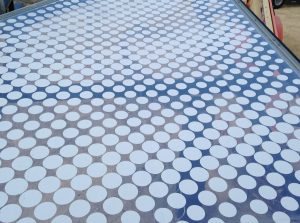We’re all familiar with ETFE structures, from the Eden Project in Cornwall, UK, to the Water Cube, The National Aquatic Centre in Beijing, China. These visually striking structures create an impression that lasts.
And while Ethylene tetrafluoroethylene is hardly a word that trips off the tongue, it’s a material that’s rising in popularity, chosen for a variety of building projects from art installations to schools.
It’s no surprise that you’re interested in using ETFE for your project, but you need to be aware of the best practices for its installation.
In this blog, we explore what ETFE film is and its many benefits, as well as the key considerations you should make when designing your ETFE structure.
What is ETFE Film?
ETFE Film is a transparent and lightweight fluoropolymer material known for its exceptional tear-resistant properties and durability, retaining qualities that make it last for over 30 years. It’s made up of a thin layer of ethylene and tetrafluoroethylene copolymer, resulting in a film that is highly resistant to ultraviolet radiation, pollution and weather conditions.
It was invented in the 1970s by the American chemical company DuPont and was originally intended to be used as an insulation material for the aerospace industry. However, its unique properties make it an attractive choice for designing architectural structures such as roofing systems, exterior cladding or facades.

What Are the Key Considerations for ETFE Installation?
Before you being to design the structure, there are 4 factors surrounding ETFE installation that you need to consider.
Layers
The first thing you need to consider is how many layers of ETFE film you need to install. This depends entirely on the purpose of your structure and the specific project requirements.
Ultimately the number of ETFE layers you use affects the thermal performance of the structure. For example, a single layer of ETFE film provides maximum transparency and light transmission, creating a bright and open space. However, it may not be as energy efficient as a multilayer configuration which will allow for more effective thermal insulation.
Cushion Shape
An ETFE cushion is made from two or multiple layers of film that are clamped together at the edges to create a sealed pocket. ETFE cushions can be flat or inflated.
The shape and size of ETFE cushions play a crucial role in achieving the desired aesthetic and performance of the structure.
The three most common cushion shapes are single-layer flat cushions, double-curvature cushions and inflated pneumatic cushions. The shape of the cushion you choose depends on factors such as architectural design, structural requirements and environmental conditions.
Thermal Control Systems
No matter what the purpose of your structure, whether an interactive art installation, entertainment venue or school, incorporating a thermal control system within your ETFE structure is essential for maintaining comfortable indoor conditions.
This can include features such as shading systems, ventilation and insulation. These systems help regulate temperature, control solar heat gain and prevent condensation.
Maintenance Considerations
While ETFE film is self-cleaning due to its smooth surface, washing clean in the rain, this does not mean that it requires no attention. To ensure the longevity and performance of your ETFE film structure, it’s important to carry out regular maintenance, including inspections, cleaning and repairs to any damage or wear.

How to Manage the Insulation Properties of Your ETFE Structure
Without taking adequate measures to manage the insulation of your ETFE structure, you may experience issues with temperature. Here are our recommendations for how to resolve this:
Solar Heat Gain
It’s common for ETFE structures to experience solar heat gain, working in a similar way to a polytunnel. This leads to increased indoor temperatures that can be uncomfortable for those inside. To mitigate this, tinted films can be applied to ETFE cushions to reduce the amount of heat entering the building while maintaining transparency.
Environmental Control Systems
Utilising environmental control systems, such as automated shading devices or natural ventilation can help regulate the internal climate of your ETFE structure and reduce the reliance on mechanical cooling or heating.
What Safety Measures Can Be Used to Protect an ETFE Structure?
As durable as ETFE film is, there are ways that you can help to protect it to further increase its longevity. Here are examples of what could cause damage to ETFE film and what you can do to prevent it.
Bird Deterrents
Due to the transparency of ETFE film, birds often collide with structures, which can cause tears or holes. There are various measures you can take, including bird netting, bird spikes or visual deterrents like reflective materials or decals.
Preparation for Heavy Snowfall
To prevent damage caused by harsh weather conditions, you should ensure that your ETFE structure is designed to withstand snow loads that are typical of the local climate.
Engineers can calculate the appropriate design parameters including the strength and spacing of structural supports. The slope and shape of the structure can enable snow shedding and prevent excessive accumulation.
Tensile Fabric Structures from ARC Structures
The construction of an ETFE structure is a significant project and when it comes to bringing your vision to life, you need to know that you’re in the right hands.
With over 20 years of experience designing, manufacturing and installing world-class tensile fabric architecture, you can rely on ARC Structures to deliver exceptional results.
If you have any questions about our services or would like to partner with us on your project, don’t hesitate to get in touch with our expert team today.


